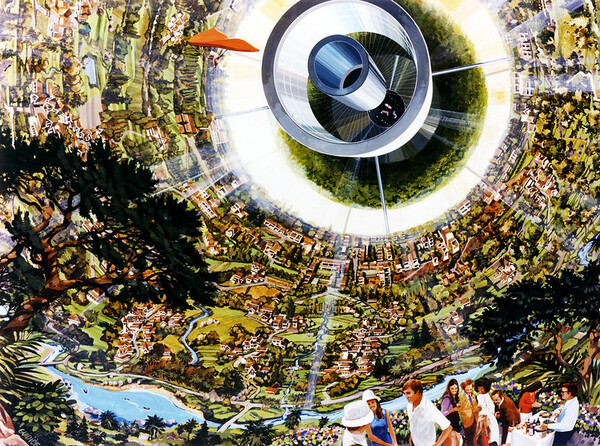This article explores: Bernal Spheres and space agriculture: Challenges and solutions for food production in space. Find out more about Bernal Spheres And Space Agriculture.
The idea of humans living in space has captured our imaginations for decades, and with the advent of private space companies and continued government investment, it is becoming increasingly likely.
As we explore the possibility of long-term space habitation, one of the most pressing issues is how to produce food in space.

Bernal Spheres, a type of space habitat that rotates to create artificial gravity, offer a potential solution for sustainable food production in space.
However, there are many challenges to overcome, including limited resources, microgravity conditions, and the need for energy-efficient and sustainable food production methods.
In this article, we will explore the challenges and solutions for food production in space using Bernal Spheres and the potential benefits that space agriculture could offer for future space exploration and life on Earth.
Can Food Be Produced On A Bernal Sphere?
Yes, food can be produced on a Bernal Sphere, which is a hypothetical space habitat designed by physicist Gerard O’Neill.
The Bernal Sphere is a spherical structure that rotates around its axis to create artificial gravity on its interior surface.
There are several ways to produce food on a Bernal Sphere. One option is to use hydroponics, which is a method of growing plants without soil, using nutrient-rich water instead. Hydroponics can be used to grow a variety of plants, including fruits, vegetables, and herbs.
Another option is to use aeroponics, which is a method of growing plants in an air or mist environment without soil or water. In aeroponics, the plant roots are suspended in air and misted with a nutrient-rich solution.
Additionally, it may be possible to produce food through cellular agriculture, which is a method of producing animal products like meat and dairy using cell cultures instead of raising animals. This technology is still in development, but it could provide a sustainable source of food in a closed system like a Bernal Sphere.
With the right technology and resources, food can be produced on a Bernal Sphere to support a self-sufficient human population.
What Are The Methods Of Producing Food In Space?
There are several methods of producing food in space.
These methods of food production in space can help support sustainable and self-sufficient human habitation in space.
Hydroponics:
Hydroponics is a method of growing plants without soil, using nutrient-rich water instead. It is a popular method of food production in space due to its efficiency and the ability to grow a variety of plants in a small space.
Aeroponics:
Aeroponics is a method of growing plants in an air or mist environment without soil or water. In aeroponics, the plant roots are suspended in air and misted with a nutrient-rich solution. This method of food production is also popular in space due to its high efficiency.
Aquaponics:
Aquaponics is a combination of aquaculture (raising fish) and hydroponics (growing plants without soil). In this method, fish are raised in a tank and their waste is used to fertilize the plants growing in a hydroponic system. The plants, in turn, clean the water for the fish. Aquaponics is a closed-loop system that is efficient and sustainable, making it an ideal method for food production in space.
3D Printing:
3D printing technology can be used to produce food in space by printing layers of edible material to create various shapes and textures. This technology is still in development but has the potential to revolutionize space food production by providing astronauts with fresh, customized meals.
Cellular Agriculture:
Cellular agriculture is a method of producing animal products like meat and dairy using cell cultures instead of raising animals. This technology is still in development, but it could provide a sustainable source of food in a closed system like a space habitat.
How Will Bernal Spheres Benefit Agriculture?
Bernal Spheres could provide a sustainable and efficient platform for agriculture in space, which could have important implications for food production on Earth as well.
Bernal Spheres could potentially benefit agriculture in several ways:
Increased efficiency:
Bernal Spheres offer a controlled environment for food production, which allows for optimal growth conditions and increased efficiency in agriculture. This controlled environment can be adjusted to provide the ideal temperature, light, and nutrient conditions for each crop, which can result in faster growth and higher yields.
Reduced dependence on earth:
With the ability to produce food in space, we can reduce our dependence on Earth for agriculture. This is especially important in the face of climate change and the potential for natural disasters or other events that could disrupt Earth’s food production.
Sustainable food production:
Bernal Spheres can support sustainable food production by using methods such as hydroponics, aeroponics, and aquaponics. These methods use less water and fertilizers than traditional agriculture and can produce higher yields in a smaller space. Additionally, Bernal Spheres can use renewable energy sources like solar power to reduce their carbon footprint.
New opportunities for research:
Agriculture in a Bernal Sphere could offer new opportunities for research on plant growth and development in microgravity and artificial gravity conditions. This research could lead to new insights and advancements in agriculture on Earth as well.
What Type Of Food Is Possible On A Bernal Sphere?
With the right technology and resources, a diverse range of foods can be produced on a Bernal Sphere to support a self-sufficient human population.
A wide variety of foods can be produced on a Bernal Sphere using methods like hydroponics, aeroponics, and aquaponics. Here are some examples of the types of food that could be grown or produced on a Bernal Sphere:
Leafy greens:
Lettuce, spinach, and other leafy greens are well-suited for hydroponic or aeroponic growing systems.
Fruits:
Strawberries, blueberries, and other small fruits can be grown in hydroponic systems, and citrus trees may be able to grow in larger spaces.
Vegetables:
Tomatoes, peppers, cucumbers, and other vegetables are well-suited for hydroponic systems and can be grown year-round.
Herbs:
Basil, cilantro, and other herbs can be grown in hydroponic or aeroponic systems and can add flavor to a variety of dishes.
Mushrooms:
Mushrooms can be grown in controlled environments and could be a source of protein for a Bernal Sphere population.
Algae:
Algae can be grown in an aquaponic system and can be used as a source of protein, as well as for producing oils, biofuels, and other products.
Cellular agriculture products:
Cell-based meat, dairy, and other animal products can be produced using cellular agriculture technology, which could provide a sustainable source of protein in a closed system like a Bernal Sphere.
References for: “Bernal Spheres and space agriculture: Challenges and solutions for food production in space”
Here are some references that can be used for an article on “Bernal Spheres and space agriculture: Challenges and solutions for food production in space”:
“Designing a Bernal Sphere for Sustainable Habitation in Space” by Calla Cofield, Space.com (2016)
“Agriculture in space: Producing food and oxygen on the moon or Mars” by Bryan Versteeg, The Conversation (2019)
“Space Agriculture and Bernal Spheres” by Loretta Hall, Ad Astra Magazine (2018)
“Growing Plants in Space: An Overview of Plant Growth Chambers, Greenhouses, and Plant Biology Research Units” by Gioia D. Massa et al., Acta Horticulturae (2016)
“Feeding Mars: The Challenges of Food Production in Space” by Robert Zubrin, Aerospace America (2017)
“Space Agriculture and Food Production” by Rebecca R. Whitlock et al., Space Science Reviews (2018)
These references provide a starting point for exploring the challenges and potential solutions for food production in space using Bernal Spheres.
‘Bernal Spheres and space agriculture: Challenges and solutions for food production in space’ is one important topic in our series exploring the role of Bernal Spheres in space colonization.
Read more about these topics by following the links below:
Republished by Blog Post Promoter
